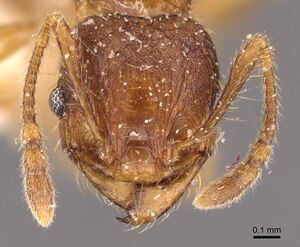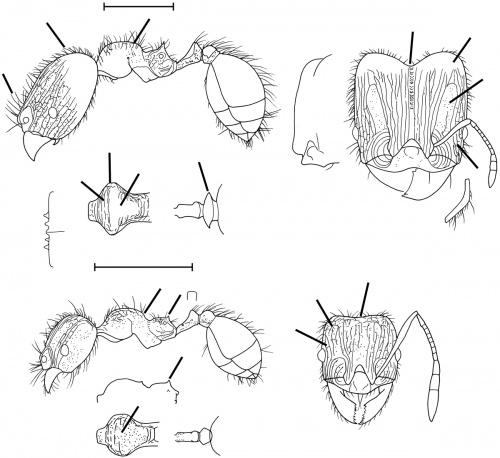Pheidole risii
| Pheidole risii | |
|---|---|

| |
| Scientific classification | |
| Kingdom: | Animalia |
| Phylum: | Arthropoda |
| Class: | Insecta |
| Order: | Hymenoptera |
| Family: | Formicidae |
| Subfamily: | Myrmicinae |
| Tribe: | Attini |
| Genus: | Pheidole |
| Species: | P. risii |
| Binomial name | |
| Pheidole risii Forel, 1892 | |
Rosumek (2017) assessed trophic resource use and period of activity within the ant community in a southern Brazil Atlantic forest. He found this species was a quintessential generalist.
Identification
See the description in the nomenclature section.
Keys including this Species
Distribution
From Wilson (2003): In addition to the type locality, risii has been recorded from São Paulo, Brazil (Kempf 1972b).
Latitudinal Distribution Pattern
Latitudinal Range: -23.5333° to -34.09145°.
| North Temperate |
North Subtropical |
Tropical | South Subtropical |
South Temperate |
- Source: AntMaps
Distribution based on Regional Taxon Lists
Neotropical Region: Argentina (type locality), Brazil.
Distribution based on AntMaps
Distribution based on AntWeb specimens
Check data from AntWeb
Countries Occupied
| Number of countries occupied by this species based on AntWiki Regional Taxon Lists. In general, fewer countries occupied indicates a narrower range, while more countries indicates a more widespread species. |

|
Estimated Abundance
| Relative abundance based on number of AntMaps records per species (this species within the purple bar). Fewer records (to the left) indicates a less abundant/encountered species while more records (to the right) indicates more abundant/encountered species. |

|
Biology
Castes
Worker
Minor
Images from AntWeb
   
| |
| Syntype of Pheidole risii. Worker. Specimen code casent0908199. Photographer Z. Lieberman, uploaded by California Academy of Sciences. | Owned by MHNG, Geneva, Switzerland. |
Nomenclature
The following information is derived from Barry Bolton's Online Catalogue of the Ants of the World.
- risii. Pheidole risii Forel, 1892a: 38 (s.w.q.m.) ARGENTINA. See also: Wilson, 2003: 740.
Unless otherwise noted the text for the remainder of this section is reported from the publication that includes the original description.
Description
From Wilson (2003): DIAGNOSIS Similar in various traits to Pheidole aper, Pheidole bambusarum, Pheidole brevicona, Pheidole dyctiota, Pheidole laeviventris, Pheidole lutzi, Pheidole rugatula, Pheidole senilis, Pheidole sigillata, Pheidole trachyderma and Pheidole traini, differing as follows.
Major: shallow antennal scrobes; pilosity along dorsal profile of head dense, with uniform short hairs about as long as Eye Length along the posterior half and much longer hairs along the anterior half; occipital cleft deep; occipital lobes smooth and subangulate; pronotum sparsely carinulate, mostly smooth; propodeal spine very stout, equilaterally triangular; postpetiolar node very broad, 2X broader than petiolar node, and spinose.
Minor: occiput, humeri, and propodeal dorsum rugoreticulate; almost all of head and mesosoma foveolate; occiput broad, concave, and lacking nuchal collar.
MEASUREMENTS (mm) Syntype major: HW 0.96, HL 1.02, SL 0.44, EL 0.12, PW 0.54. Syntype minor: HW 0.66, HL 0.66, SL 0.62, EL 0.12, PW 0.44.
COLOR Major: body reddish yellow except for gaster, which is yellowish brown.
Minor: concolorous dark yellow.
Figure. Upper: syntype, major. Lower: syntype, minor. Scale bars = 1 mm.
Type Material
ARGENTINA: Buenos Aires, col. Fr. Ris. Musee d'Histoire Naturelle Genève and Museum of Comparative Zoology - as reported in Wilson (2003)
Etymology
Named after the collector, Fr. Ris. (Wilson 2003)
References
- Wilson, E. O. 2003. Pheidole in the New World: A dominant, hyperdiverse ant genus. Harvard University Press, Cambridge, MA. (page 740, fig. major, minor described)
- Albuquerque, E., Prado, L., Andrade-Silva, J., Siqueira, E., Sampaio, K., Alves, D., Brandão, C., Andrade, P., Feitosa, R., Koch, E., Delabie, J., Fernandes, I., Baccaro, F., Souza, J., Almeida, R., Silva, R. 2021. Ants of the State of Pará, Brazil: a historical and comprehensive dataset of a key biodiversity hotspot in the Amazon Basin. Zootaxa 5001, 1–83 (doi:10.11646/zootaxa.5001.1.1).
- Forel, A. 1892a. Notes myrmécologiques. Ann. Soc. Entomol. Belg. 36: 38-43 (page 38, soldier, worker, queen, male described)
- Kempf, W. W. 1972. Catálogo abreviado das formigas da região Neotropical. Stud. Entomol. 15: 3–344.
- Lutinski, J., de Filtro, M., Baucke, L., Dorneles, F., Lutinski, C., Guarda, C. 2021. Ant assemblages (Hymenoptera: Formicidae) from areas under the direct influence of two small hydropower plants in Brazil. Brazilian Journal of Environmental Sciences (Online), 1-9 (doi:10.5327/Z217694781030).
- Rosumek, F. B. 2017. Natural History of Ants: What We (do not) Know about Trophic and Temporal Niches of Neotropical Species. Sociobiology. 64:244-255. doi:10.13102/sociobiology.v64i3.1623
References based on Global Ant Biodiversity Informatics
- Calcaterra L. A., F. Cuezzo, S. M. Cabrera, and J. A. Briano. 2010. Ground ant diversity (Hymenoptera: Formicidae) in the Ibera nature reserve, the largest wetland of Argentina. Ann. Entomol. Soc. Am. 103(1): 71-83.
- Drose W., L. R. Podgaiski, C. Fagundes Dias, M. de Souza Mendonca. 2019. Local and regional drivers of ant communities in forest-grassland ecotones in South Brazil: A taxonomic and phylogenetic approach. Plos ONE 14(4): e0215310.
- Favretto M. A., E. Bortolon dos Santos, and C. J. Geuster. 2013. Entomofauna from West of Santa Catarina State, South of Brazil. EntomoBrasilis 6 (1): 42-63.
- Forel A. 1908. Ameisen aus Sao Paulo (Brasilien), Paraguay etc. gesammelt von Prof. Herm. v. Ihering, Dr. Lutz, Dr. Fiebrig, etc. Verhandlungen der Kaiserlich-Königlichen Zoologisch-Botanischen Gesellschaft in Wien 58: 340-418.
- Kempf, W.W. 1972. Catalago abreviado das formigas da regiao Neotropical (Hym. Formicidae) Studia Entomologica 15(1-4).
- Kusnezov N. 1952. El género Pheidole en la Argentina (Hymenoptera, Formicidae). Acta Zoologica Lilloana 12: 5-88.
- Kusnezov N. 1978. Hormigas argentinas: clave para su identificación. Miscelánea. Instituto Miguel Lillo 61:1-147 + 28 pl.
- Luederwaldt H. 1918. Notas myrmecologicas. Rev. Mus. Paul. 10: 29-64.
- Lutinski J. A., B. C. Lopes, and A. B. B.de Morais. 2013. Diversidade de formigas urbanas (Hymenoptera: Formicidae) de dez cidades do sul do Brasil. Biota Neotrop. 13(3): 332-342.
- Piva A., and A. E. de C. Campos. 2012. Ant Community Structure (Hymenoptera: Formicidae) in Two Neighborhoods with Different Urban Profiles in the City of Sao Paulo, Brazil. Psyche 2012 (390748): 1-8
- Rosa da Silva R. 1999. Formigas (Hymenoptera: Formicidae) do oeste de Santa Catarina: historico das coletas e lista atualizada das especies do Estado de Santa Catarina. Biotemas 12(2): 75-100.
- Santschi F. 1916. Descriptions de fourmis nouvelles d'Afrique et d'Amérique. Annales de la Société Entomologique de France 84: 497-513.
- Santschi F. 1916. Formicides sudaméricains nouveaux ou peu connus. Physis (Buenos Aires). 2: 365-399.



